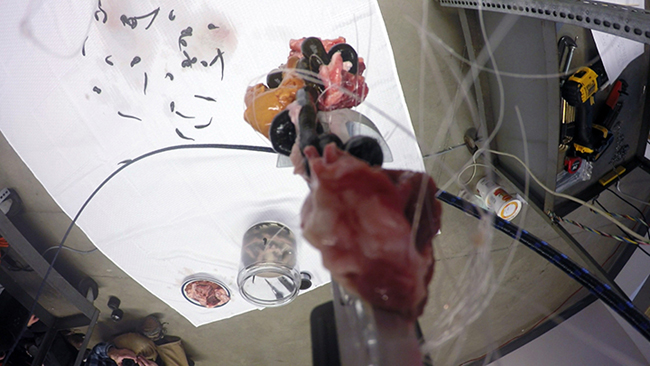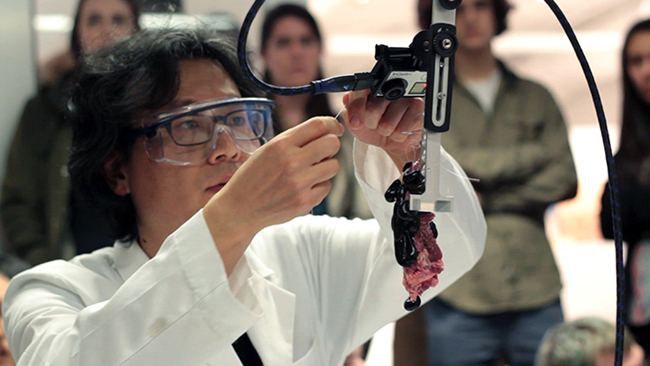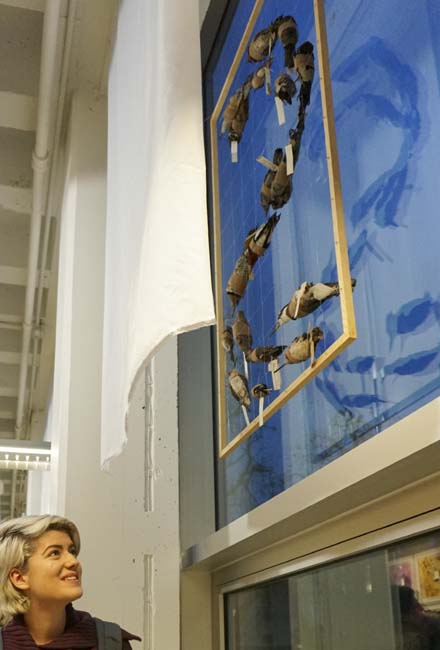By Annie Jacobson, PhD Candidate, Ohio State History of Art Department
On an unseasonably mild December evening, I walked across the Oval to Hopkins Hall to attend the opening BioPresence, an exhibition representing the culmination of months of planning, organizing, learning, and, of course, artistic exploration. Its theme represented the ongoing work of numerous people and entities across campus. Artists (both student and professional), were asked to create works about noticing and sensing all the living things on campus and in the local urban environment, documenting the “unique urban ecosystem” in which we all live and work. Invited to write about the show by one of the coordinators, professor Ken Rinaldo, I arrived at the opening celebration with little foreknowledge, wanting to let the exhibition speak to me on its own terms. What I found was a truly multifaceted show displaying an array of technological interventions into nature that allowed visitors unique perspectives on all types of life at Ohio State. From smorgasbords for squirrels and repurposed flea market paintings to slime mold dances and horse vision, the works in the exhibition ranged from clever and humorous to darkly striking and thought provoking.

The Inaugural Performance of Doo-Sung Yoo’s Leech Project at the Opening Reception of the ‘BioPresence’ Exhibition Hopkins Hall Gallery, Columbus, Ohio December 9th 2015
The exhibition, open for just one short week, filled the gallery and first floor in Hopkins Hall as well as parts of the upper floors, impressive considering that not all the works submitted to the show were selected for viewing. The arrangement of the works was carefully done, providing visitors a path to follow that also told the story of the ongoing BioPresence project—no small feat considering the number of works in the show. At the opening on December 8, Hopkins was filled with people weaving in and among the works, interacting with pieces that included a helmet that measures brainwaves designed and created with a 3D printer by student Jer Viny, a geodesic sensory deprivation apparatus, and a computer card game featuring the oft-underappreciated bacterium. Linked with many of the artworks was documentation of the process the artist used to arrive at his or her completed piece, an addition to the show which helped the viewers more completely understand how that work fit into the show’s theme. While giving me a tour of the exhibition opening night, Rinaldo, head of the Art and Technology program in the Department of Art, suggested to me that technologies such as robotics, animation software, and video and sound recording provide contemporary artists with the most current and relevant opportunities for creativity and exploration in our time, and even with the theme to focus the works, the variety was impressive.
Among the most mesmerizing was first_contact by Axel Cuevas Santamaría, a video and sound work documenting the lowly slim mold Physarum polycephalum, which was rejected by scientists from the Animalia, Plantae, and Fungi kingdoms. These molds are single-celled beings, but they aggregate together to form reproductive structures and roll, glide, and slither around as they search for items on which to grow. Santamaría filmed in extreme close-up the molds moving gracefully across petri dishes. Then, in a small, darkened room, the recordings, featuring an array of colors from gold to green, were projected onto circular screens on the floor. The molds danced and sparkled to music electronically derived from their own movements, and the longer I watched them, the more they seemed to simultaneously resemble the surfaces of distant alien planets, the flowing forms of the lowly molds turning into powerful rivers or enormous storms. The round projection screens seemed to float in the dark, orbiting around one another, and as I stood in the black intermediary of the room, the varying levels of magnitude from the tiniest of organisms to the unfathomable vastness of space seemed to press in on me. Even the title itself alludes to cutting edge of discovery by scientists, be they pointing their microscopes to the smallest of life on Earth or aiming telescopes into the endless depths of the universe. Easily one of the strongest pieces in the show, first_contact captures how the marriage of nature and technology can produce both aesthetic and philosophical beauty, enticing viewers to think beyond their environment in both large and small ways.

The Inaugural Performance of Doo-Sung Yoo’s Leech Project at the Opening Reception of the ‘BioPresence’ Exhibition Hopkins Hall Gallery, Columbus, Ohio December 9th 2015
Another highlight was the presentation of the Bioacoustic Urbanscapes, a compilation of audio artworks featuring animal sounds, organized in part by TradeMark Gunderson, himself an audio artist. Earlier in the year, a call went out to artists from around the world for submissions that creatively used recordings of animals sounds from the urban environment. Artists had access to over 40,000 recordings from Ohio State’s own Borror Laboratory of Bioacoustics, another partner in the BioPresence project, as well as more recent recordings from wetlands near Ohio State’s campus taken this past spring and summer. The winning works were selected by members of the art department faculty and Angelika Nelson, the curator of the Museum of Biological Diversity at the Borror Lab, and presented in an upstairs classroom with an enveloping sound system. From experimental pieces to melodic songs, the creative array of audio works was impressive, and the compilation provided a fascinating addition to the visual works in the exhibition, although its out-of-the-way location prevented a wider audience from experiencing it.
Amy Youngs’s Strike, displayed on the windows of the second floor facing the interior courtyard of Hopkins Hall, was a provocative and prominent addition to the show. From a distance, it spelled out the word “strike” in large letters. The ominous word hung above the visitors heads as they viewed some of the more whimsical pieces below. Upon closer inspection, the letters were fashioned with the bodies of birds. Although I could not identify many of the bird species, it was clear that a wide range of birds were included. I imagined the birds in their live state: flying joyously through clean blue skies, searching for bits of fluff or sticks to create nests or newly-surfaced worms for a morning meal. Their dead bodies seemed deflated and sad, reinforcing the impact of the large word seen from a distance. Youngs explained that the birds themselves had died when they struck large windows, an increasingly common occurrence as more and more contemporary buildings feature wide expanses of reflective glass. Created to call attention to this phenomenon, the birds were donated to the project from the Ohio State Museum of Biological Diversity, who document where and when the birds perish and preserve them for future study. This is an issue that is being addressed around the country, as the University of San Diego recently partnered with the University of Minnesota to test a special window coating to help deflect birds from windows.

STRIKE detail of bird installation by Amy Youngs, ‘BioPresence’ Exhibition, Hopkins Hall Gallery, Columbus, Ohio December 9th 2015
One of the highlights of the opening was Doo-sung Yoo’s untitled performance piece staged near the entrance to the gallery space. Yoo himself was integral to the planning of the exhibition and a well established artist in video production and performance. Much of his work deals with how humans and animals are interconnected and interdependent, and these themes were clearly in mind for his live piece. It was hard not to have a visceral reaction to the work—there was literally a plate of viscera sitting on a table laid out as through at a restaurant, alongside a glass of wine and a loaf of bread. The table was positioned next to an elaborate contraption consisting of two metal drawer units rigged with upright posts which held between them by means of fishing wire a GoPro camera with approximately 6 inch metal post attached to it. The fishing wire was threaded through two robotic gears that moved the camera up and down and side to side. In the grand tradition of performance art, gallery-goers were confused and intrigued by this set up. As it was his first time executing this performance, Yoo at first seemed to scramble to get the set up exactly right. When I walked up, he was down on his knees, busy transferring about 3 dozen leeches from a bucket to three glass containers of various sizes. I’m not generally a squeamish person, but, seeing the plate of viscera, I had some idea of where the performance was going, and although my stomach objected, I couldn’t tear myself away.
Others visitors to the exhibition drifted around, impatient for the performance to start. When each element in the elaborate set-up was ready, Yoo carefully donned button down shirt and tie, sat down at the table, and began pouring himself wine. Sitting in front of the wine, bread, and large plate of raw organs, Yoo began cutting the bloody mass into smaller pieces. The plate could barely hold its contents, and some of the liquid spilled over the edge to stain the pristine white tablecloth. He transferred the pieces to a smaller plate, and after taking several drinks from the wine, stood up to move over to the robotic contraption and the leeches. Carefully placing the plate of leech delicacies on the floor, Yoo strung up the raw innards on fishing wire and began to transfer pieces of intestine, heart, and other unidentifiable organs into the glass containers, beginning the leech feast. I was both mesmerized and repulsed to see the little creatures latch on to the meats and swell as the ate their fill. Then, with the leeches clinging to the viscera, Yoo carefully pulled them from their glass jar and tied them to the camera apparatus. Some of the leeches fell onto the white cloth beneath with a soft splat, eliciting groans and squeals from the crowd. When Yoo sent the leeches flying up and down between the supports, some of them were flung dangerously close to the audience; I even had to jump back to avoid one of the little guys landing on my shoe. I had expected to see art works elucidating the relationships between human and animal, but not to have my own personal encounter with one! As the leeches flew around with the little GoPro camera (also equipped with a magnifying lens), the live feed was projected on the wall behind the machine, a large image revealing the event from the perspective of the leeches themselves. Although I was unclear on the deeper meaning Yoo intended for the performance, it was certainly entrancing. I hope that I get to see the next iteration (although I’ll go to that one on an empty stomach).
The BioPresense exhibition was part of a larger initiative that has been ongoing through the fall 2015 semester and connects artists, designers, scientists, and philosophers from all around campus. Representatives from the department of Civil, Environmental and Geodetic Engineering and the School of Environment and Natural Resources mingled with faculty from Classics, Comparative Studies, and of course, the Department of Art. The idea for the project began with conversations between the organizers about the ways animals worlds influence the fields of the arts, sciences, and humanities—and the lack of animals studies around campus. As sustainability becomes a more and more pressing issue locally and globally, this group of faculty wanted to specifically call attention to how we co-exist with the animals and plants on the Ohio State campus.
Spearheaded by Department of Art professor Amy Youngs, the group applied for a university Framework Grant from the Office of Academic Affairs. The grant is specifically for faculty who will improve the Ohio State community through “creative and collaborative place-based projects.” The goal of the project was to make the animals and their ecosystems in and around campus more visible and to get people talking about sustainability. With the money they received from their winning application, Youngs and Rinaldo were able to purchase new equipment and software for the more than 200 students that were enrolled in the fall’s Art and Tech curriculum, including such courses as 3D animation, internet art, holography, and video art. The abundance of resources showed in the great array of projects in the BioPresence exhibition, and as Professor Youngs told me, it is especially helpful for the young artists in the program to focus their final projects of the semester around a specific theme, as this is how a majority of professional art exhibitions are organized.
The theme of the project is a worthy one: as our planet faces great changes as a result of global climate change, we must consider how our actions on Earth affect not only ourselves, but the nearly endless multitude of other life that calls this little rock home. Artists in the exhibition spent months thinking about our urban landscape (so often only thought of as a space for human inhabitants) from the perspectives of numerous other creatures, and their works allowed viewers a chance not only to similarly delve into these other viewpoints, but also to see how artistic exploration explored through technology often results in works particularly of our early 21st century moment.
– Annie Jacobson, NY Arts























